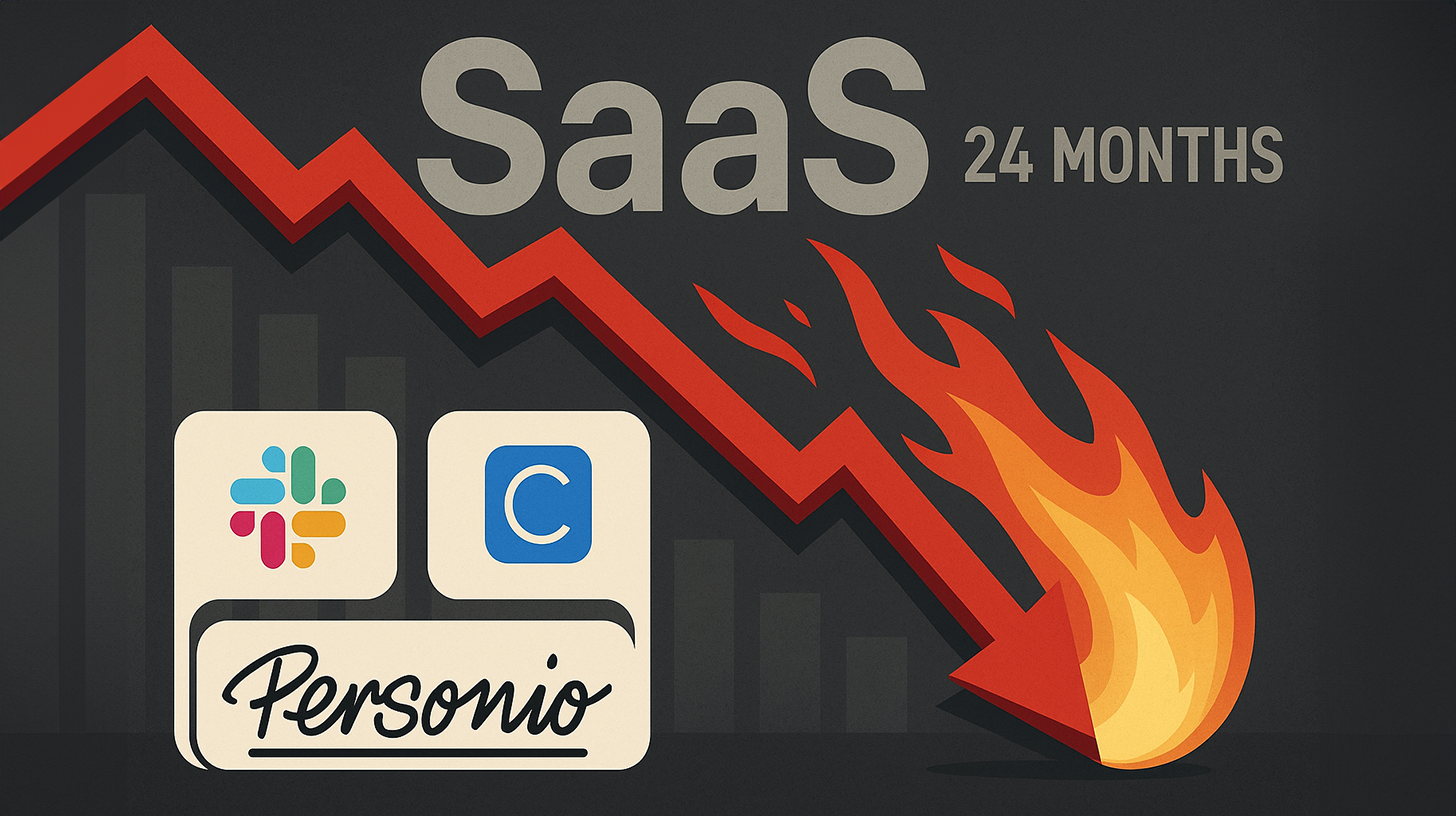
The SaaS crisis: from hype to negative reality in 24 months-affected: Slack, Calendly and Personio-Image: Xpert.digital
The turning point of the SaaS industry: Why successful companies are stumbling
Market analysis: The impending decline in large SaaS companies
The software-as-a-service (SaaS) industry is facing a massive turning point. After years of explosive growth and astronomical reviews, current market data show that established SaaS companies such as Slack, Calendly and Personio face considerable challenges. The following article analyzes why the SaaS stars of the last decade could possibly become the biggest losers over the next 24 months.
The end of an era: the current status of the SaaS market
The global Saas market remains impressively large-in 2025 it was estimated at around $ 250 billion and is expected to grow to $ 299 billion by the end of the year. Other forecasts are even more optimistic and forecast growth to $ 307.3 billion by 2026, with an annual growth rate of 11.7%. Long-term estimates see the market by 2034 even over $ 1.2 trillion.
But behind these impressive numbers there are questionable trends. The valuation multipliers for SaaS companies have dropped significantly. SaaS companies are currently rated an average of 6.2 times their annual sales, which is below the historic 5 and 10 year average of 8-9 times. The BVP Nasdaq Emerging Cloud Index shows a decline in sales multipliers to 5.79x in the second quarter of 2024, a minus of 10% compared to the end of 2023.
Particularly alarming: The average sales growth of SaaS companies fell to 12.31% in 2024, compared to 19.85% in the previous year. This signals a significant slowdown in industry growth and indicates increasing market saturation.
Suitable for:
Case studies of distress: Slack, Calendly and Personio
Slack: The communication giant under pressure
Slack was taken over in 2020 for an impressive $ 27.7 billion from Salesforce. In 2023, the company generated sales of $ 1.7 billion, which corresponds to growth of 17% compared to the previous year. Although these numbers appear solid, there are signs of problems. In user circles there are increasing complaints about the reliability of the service since the takeover by Salesforce. The growth rate of 17% is also significantly below the company's earlier expansion rates when Slack grew by 30-40% annually.
Calendly: billion dollar business for scheduling
Calendly achieved an assessment of $ 3 billion in January 2021 at his last round of finance. The company increased its turnover of $ 70 million in 2020 to $ 143.7 million in 2022. Calendly seems to be well positioned with around 10 million active users. Nevertheless, the question arises whether a simple schedule is justified this assessment, especially in view of the increasing AI-based alternatives.
Personio: The HR giant in difficulties
The German HR Tech company Personio offers a particularly revealing example. In November 2024, the company announced organizational changes and dismissed around 115 employees, which corresponds to 6% of the workforce. As early as January 2024, Personio released around 100 employees, mainly from the product and technology department. Personio's turnover grew to $ 241.5 million in 2023, but the repeated layoffs indicate deeper problems.
CEO Hanno Renner admitted in an internal message that the company overestimated its growth. He explained that the investment decisions in recent years were based on the assumption that the extraordinary growth rates would stop. As the reasons for the current situation, he cited external challenges, such as a weaker economy and internal problems with the implementation of growth strategies.
AI and Open Source: The new disruptors
Perhaps the largest threat to established SaaS providers comes from AI-based solutions and open source alternatives. Chatgpt has developed into the leading “Shadow IT” application in companies within a very short time and overtakes traditional tools such as LinkedIn, Canva and Adobe Acrobat. This development shows how quickly AI-based solutions are adopted by employees-often without official approval from the IT department.
The integration of AI in corporate processes is progressing rapidly. According to current surveys, 49% of companies are already relying on AI systems, and another 30% plan to do this in the future. It is noteworthy that 48% of companies that use AI have replaced human workers. These numbers underline the disruptive potential of AI for conventional software solutions.
At the same time, low code and no-code platforms experience an upswing. A significant increase in adoption is predicted for 2025, as these platforms are increasingly integrating AI functions that further simplify the development. This also enables smaller teams to create complex applications that used to have large development teams.
Suitable for:
The future of the SaaS: Who survives, who disappears?
The data draws a clear picture: the SaaS market is in a phase of consolidation and re-evaluation. Commodity theory, which is mentioned in several sources, states that SaaS products are increasingly interchangeable, which leads to an intensive price competition, lower margins and ultimately a “Race to the bottom”.
McKinsey reports that only the upper quarter of the SaaS companies achieve sales growth of over 40%, while many companies have difficulty maintaining their growth. BCG notes that the B2B Saas sector continues to grow, but suffers from intensive competition, especially from new market participants who offer similar solutions at lower prices.
Who will survive?
SaaS providers who solve complex problems and offer real added value have better chances of survival. This includes:
- Specialized solutions for niche industry with high regulatory requirements
- Platforms that integrate AI seamlessly and offer real productivity advantages
- Companies that go beyond pure software and create comprehensive service ecosystems
Who will disappear?
- Generic SaaS solutions, the functions of which can easily be replaced by AI-based tools
- Overvalued companies that have rely on growth instead of profitability
- Providers who have overslept the AI trend and are now trying to catch up
24 hard months ahead
The next two years will be a time of painful adaptation for many SaaS companies. The combination of falling reviews, slow growth and disruptive technologies such as AI and Open Source creates a perfect storm scenario. Companies that have built up their ratings on unrealistic growth expectations are particularly at risk.
HR solutions such as Personio already feel the triple pressure from a declining demand, increased price pressure and disruption through internal AI solutions. The layoffs at Personio are probably only the tip of the iceberg.
The Saas market does not die-it is changing fundamentally. However, the illusion that a single feature or a simple function justifies a sustainable business model. In a world in which companies are increasingly developing their own tailor-made solutions with AI and low-code tools, SAAS providers have to offer a real, difficult to replicating added value.
The winners will be the ones who quickly adapt, integrate Ki proactively and concentrate on the solution really complex problems. The losers will be those who stick to outdated business models and underestimate the fundamental change in software development by AI.
For companies and investors in the SAAS area, the time to critically question business models and to adapt to the new reality is now. The next 24 months will undoubtedly be challenging - but you will also clearly show which companies are really sustainable.
Suitable for:
Your global marketing and business development partner
☑️ Our business language is English or German
☑️ NEW: Correspondence in your national language!
I would be happy to serve you and my team as a personal advisor.
You can contact me by filling out the contact form or simply call me on +49 89 89 674 804 (Munich) . My email address is: wolfenstein ∂ xpert.digital
I'm looking forward to our joint project.

